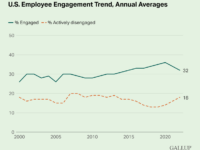In our experience, organizations generally do a good job of communicating with impacted employees and providing reasonable severance. If there are gaps, they usually come post-reduction in how the company engages with the employees who are still there, which can lead to critical attrition, burnout, and disengagement.
Communications focused on stability
In most cases, employees want reassurance about stability and that there won’t be more layoffs in the future. While most organizations aren’t in a position to guarantee future staffing levels, being intentional about regularly communicating business health metrics/KPIs and wins is a powerful way to create confidence amongst employees. Important that this is both “top-down” as well as “leader-led” – leaders are both impacted stakeholders themselves and key conduits of information for their teams. Leverage technology to cascade pre-packaged messages to leaders they can easily re-share with their teams digitally and out loud to support the internal comms work you’re already doing.
Pulse check with teams
After the dust has settled a bit, we strongly encourage capturing feedback through one or more short pulse surveys and/or leader-led standup meetings on how employees are feeling about the changes, what concerns if any they still have, and if the key communications messages you had shared surrounding the layoffs with employees have “stuck”. This will give you key insight into how to alleviate employee concerns. Critical of course to act on this feedback (see below).
Celebrations
Birthdays, work anniversaries, return from leave, promotions, hitting goals, living values, and great work are all important opportunities to celebrate individuals and teams. While to be respectful some companies may pause this activity in the immediate 2-3 days following a reduction, it’s critical to be intentional about celebrating others and to foster a “culture of celebration” if one does not already exist. Leveraging technology that makes this easy (automated and timely reminders for leaders), delightful/fun (virtual cards, GIFs, emojis, badges), easy (embedded in the tools everyone uses already), and impactful (maximize visibility where appropriate) is key to driving celebrations at scale. Otherwise, employees will feel undervalued as people and contributors, yielding disengagement and turnover.
Leadership Burden
Frontline leaders will arguably more than anyone feel the “weight” of the layoffs – they are simultaneously wrestling with any concerns they have themselves as well as working to alleviate those from their team members. As such, Leader support is critical – both in directly navigating the layoff wake themselves and with their teams, as well as more generally in their day-to-day responsibilities. For the former, delivering timely, “snackable” wellbeing resources and tips to leaders (vs. making them go find them) is a simple and helpful show of support. For the latter, review recent engagement survey results to identify 1-3 opportunities you can invest in providing better leader support for. Otherwise, expect leader burnout and attrition to rise.
Engagement Action Plans
It’s reasonable to expect a decline in engagement survey scores following layoffs. Taking action based on employee feedback is always important, but critically so in the wake of layoffs or other challenging business circumstances. Lack thereof will fuel disengagement, dissatisfaction, and misperceptions amongst employees.
Organizations often have great intentions with post-engagement survey action planning, but struggle with execution due to (1) the complexity and time consuming nature of creating action plans at scale, (2) leaving Leaders largely on their own to translate directional guidance from survey results into specific weekly actions they can take to improve, and (3) inability to directly measure completion – often relying on self-reporting or waiting for the next survey.
Consider investing in technology that automates (1) leader-level action plan creation based on their survey results, (2) delivery of pre-packaged actions they can take right from the tools they already use everyday, and (3) direct measurement of actions taken and efficacy.
Investing while reducing costs
Finally, it may seem counterintuitive to make new investments on the heels of reducing costs via layoffs. In our experience, small incremental investments in the above send signals of stability and growth and can pay huge dividends in mitigating attrition and increased engagement. There may also be opportunities to rationalize various point solutions into a more comprehensive platform, creating further efficiencies.
Would be happy to discuss any of these or other best practices further if it would be helpful, including how Bonfyre can help.



 4 min
4 min




